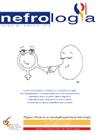综合癌症中心的药理学肾毒性概况:20年来发生了什么变化以及血液透析需求和死亡率的预测因素
IF 2
4区 医学
Q2 UROLOGY & NEPHROLOGY
引用次数: 0
摘要
简介与目的急性肾损伤(AKI)是肿瘤住院患者常见且严重的并发症。然而,癌症患者院内药物相关AKI的总体数据很少。我们的目的是回顾过去二十年来肿瘤医院收治的中度至重度药物性AKI患者的概况,并评估肾脏和整体预后。材料与方法对某综合癌症中心2002年至2021年20年间的410例KDIGO≥2的药物性AKI病例进行分析。结果两组患者的主要差异是引入了新的癌症治疗类别(如免疫检查点抑制剂[ICPI]和酪氨酸激酶抑制剂[TKI]),铂类药物引起的肾毒性降低,而多种药物未经癌症靶向治疗引起的肾毒性增加。死亡率相似,但第二个十年血液透析(HD)的需求较高(25.5% vs 36.6%, p = 0.02)。多因素分析显示,有创机械通气和脓毒症是HD和死亡率的危险因素,血液学癌症是HD的危险因素,HD和无癌症定向治疗的多种药物的需求是死亡率的危险因素。结论在综合性癌症中心,充分的药物监测和预防使癌症治疗成为药物性AKI的一个相对较小的因素。危重患者对HD的需求更高,死亡率也更高,无论是否使用肾毒性药物。本文章由计算机程序翻译,如有差异,请以英文原文为准。
Pharmacological nephrotoxicity profile in a comprehensive cancer center: What changed in two decades and predictors for the need for haemodialysis and mortality
Introduction and objectives
Acute kidney injury (AKI) is a frequent and severe complication in hospitalised cancer patients. However, overall data from in-hospital drug-related AKI in cancer patients is scarce. We aim to review the profile of moderate to severe drug-induced AKI in patients admitted to an oncology hospital over the last two decades and to assess renal and overall outcomes.
Material and methods
410 cases of drug-induced AKI KDIGO ≥ 2 were analyzed, comparing between two decades from 2002 to 2021 in a comprehensive cancer center.
Results
The main differences were the introduction of new classes of cancer therapy (e.g., immune checkpoint inhibitors [ICPI] and tyrosine kinase inhibitors [TKI]), a decrease in nephrotoxicity due to platinum-based drugs, and an increase in nephrotoxicity caused by multiple drugs without cancer-directed therapy. Mortality was similar, but the need for haemodialysis (HD) was higher in the second decade (25.5% vs 36.6%, p = 0.02). Multivariate analysis presented invasive mechanical ventilation and sepsis as risk factors for both HD and mortality, haematologic cancer as risk factors for HD, and the need for HD and multiple drugs without cancer-directed therapy as risk factors for mortality.
Conclusion
Adequate drug surveillance and prophylaxis render cancer therapy as a relatively small contributor to drug-induced AKI in a comprehensive cancer center. Critically ill patients have a higher need for HD and mortality regardless of the nephrotoxic agent implied.
求助全文
通过发布文献求助,成功后即可免费获取论文全文。
去求助
来源期刊

Nefrologia
医学-泌尿学与肾脏学
CiteScore
3.40
自引率
7.70%
发文量
148
审稿时长
47 days
期刊介绍:
Nefrología is the official publication of the Spanish Society of Nephrology. The Journal publishes articles on basic or clinical research relating to nephrology, arterial hypertension, dialysis and kidney transplants. It is governed by the peer review system and all original papers are subject to internal assessment and external reviews. The journal accepts submissions of articles in English and in Spanish languages.
 求助内容:
求助内容: 应助结果提醒方式:
应助结果提醒方式:


